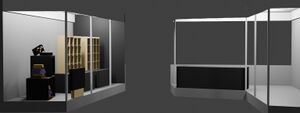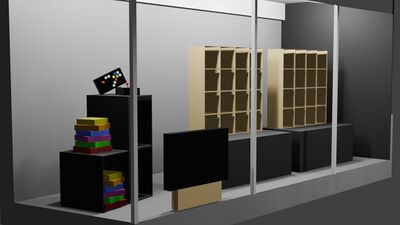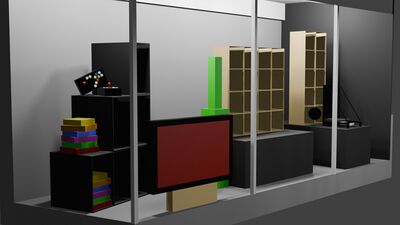Window Display
Concepts
Left Window 3 Zone
Variant 1
This concept features three zones. It includes a drape covering the back of the display area to create visual separation from the lab working space.
The first zone, with three boxes near the front of the window, would feature tabletop games and arcade controls. It would include the names, times, and dates of the events and a QR code for each event. The bottom 12" and both side 12-24" of the front window would be available for white vinyl text or iconography.
The second zone, with a table and 16 of the cubbies, would feature Lego Day elements taken from the current left window display. It would include a collection of Lego creations which could be rotated and could include an award winner area. It would include the event name, time, and date, and a QR code. The bottom 12" of the center side window would be available for vinyl text.
The third zone, with a table and 16 of the cubbies, would feature Sewing Meetup elements which would need to be sourced. It could temporarily feature 3D printed elements, of which we have plenty, but which already have a display area in the right window display. It would include the event name, time, and date and a QR code. The bottom 12" of the right side window and the right 24" would be available for white vinyl text.
The curtain covering the back of the space could be in white or black to create an unobtrusive background, or could be in a bolder color to draw attention from passersby into the window display.
The PiSignage event display would remain. The bottom 12" of the left side window would be available for white vinyl text. Depending on the placement of the PiSignage display, the sides of the left window may support vinyl text also.
Variant 2
This variant is based on the first variant, but features an active 3D printer on the back table. The cubbies would feature a range of example 3D prints, and the motion of in-progress prints would be a strong eye-catcher.
Because the back table would be rotated to accommodate the depth of the printer, the middle table could be moved right to be centered in the window pane. That would leave some extra room on the left end of the center table. Enough room for the Lego Tower, which would go nicely since the center table will feature a Lego Day display.
Notes
- Tabletop Game Max Size: 12" x 12" x 4"
Samples
Katy's Seed Ideas
Collection by Katy Osterwald: https://www.pinterest.com/modularmodular/makerspace-window-ideas/
A few of my favorites:
The clean Arial / Helvetica ones seem easier. I feel like the more artsy ones look better, but would require a better artistic eye.
More Links
- Rube Goldberg Machine: https://www.makerspace.org.uk/blog/2014/12/christmas-window-display/
Model

File:Window Display Model.blend (uses imperial units, with foot increment, and Blender 1.41.0)
Photos
2024-05-02
-
Lego Tower
-
Lego Table 1
-
Lego Table 2
-
Small Thing Cubby
-
Labyrinth
-
PiSignage Events
-
PiSignage Made Here
-
3D Printing
-
Robotics Awards
-
Laser Cutting 1
-
Laser Cutting 2
-
Jasper and Laser Lake
-
Jewelry Making
-
We Don't Sell
-
Left Window 1
-
Left Window 2
-
Right Window 1
-
Right Window 2
-
Right Window 3
Materials
Sheet Goods
- In the welding room, there are 9 pieces of assorted plywood, roughly 36" x 48". Some is bowed, some has delamination, but there should be some usable material.
- I (Bob Bushman) have some sheet stock that came from HeatSync the last time we had some excess buildup. That includes up to full sheets, and is in better condition than the stuff in the welding room.
Fonts
DaFont
The DaFont web form seems broken. Hack this link: https://www.dafont.com/theme.php?cat=102&l[]=1&l[]=10&text=%3CSample%3E
- Change cat=102 to whatever category you want, use "theme.php", not the other .php page the form takes you to. That page is broken.
- The &l[]=1&l[]=10 sets the GPL or Totally Free flags.
- &text sets the sample text to display
Comic Sans
Not sure whether I like comic sans for this, but I wanted to have a few versions for mockups.
- Plain, allcaps: Mabook
- Plain, smallcaps: CoffeeCake
- Dramatic, lowercase: Skincake
GPT Research
Engagement Process
Creating an effective window display that turns passersby into customers involves a strategic approach, leveraging both visual appeal and psychological triggers. Here’s a detailed breakdown of the steps you might consider to convert onlookers into customers effectively:
Capture Attention
- Visual Impact: Use bold colors, contrasting themes, or dynamic lighting to catch the eye of passersby. The first impression is crucial, so make sure your display stands out from its surroundings.
- Seasonal or Trendy Themes: Align your display with current trends, holidays, or seasons to make it timely and relevant, which naturally attracts attention.
- Movement and Change: Incorporate moving elements or digital displays that change. Motion catches the eye quicker than static displays.
Engage Interest
- Storytelling: Create a narrative around your products. Arrange items to tell a story or convey a lifestyle that resonates with your target audience. This can be a day in the life, a problem-solving scenario, or a dream-like setup.
- Layering and Depth: Use the foreground, middle, and background effectively to create a sense of depth. This encourages viewers to look longer as they discover more layers within the display.
- Interactive Elements: If feasible, include interactive elements such as QR codes that can be scanned for more information or mirrors that invite interaction.
Stimulate Desire
- Highlight Benefits and Features: Showcase the benefits of the product, not just features. For example, if displaying clothing, show it in a way that highlights comfort, style, and utility.
- Focus on Lifestyle Aspiration: Position your products as gateways to a desirable lifestyle. If you’re selling kitchenware, for example, set up a luxurious, cozy kitchen scene that invites viewers to imagine their life enhanced by your products.
- Sensory Appeal: Use elements that appeal to the senses where possible, such as scent diffusers in a home goods store or playing the sounds that complement the display theme (e.g., beach sounds for summer products).
Call to Action (CTA)
- Clear Messaging: Use clear and compelling signage within the display that tells the viewer what to do next. Phrases like “Discover more inside,” “Limited offer,” or “Join us” can prompt immediate action.
- Urgency and Scarcity: Communicate any urgency or scarcity related to the offer—like limited edition items or a sale ending soon—to create a fear of missing out (FOMO).
- Easy Next Steps: Make sure it’s obvious how they can act on their impulse. This could be an invitation to try something on, a flyer they can take with them, or visible staff ready to assist further.
Maintain Connection
- Follow-Up Mechanisms: Encourage further engagement through social media prompts or offering a newsletter sign-up via a QR code that can be easily scanned.
- Visibility of Store Information: Ensure your store hours, website, and social media handles are easily visible to anyone interested in learning more later.
Each of these steps should be tailored to fit the brand’s identity, the specific products being promoted, and the target audience’s preferences and behaviors. The more seamlessly these elements are integrated, the more natural the transition from onlooker to customer will be.
Text for Window Vinyl
- Create. Innovate. Share.
- Turn Ideas into Reality
- Build. Learn. Collaborate.
- Where Technology Meets Artistry
- Explore New Skills, Tools, and Technologies
- DIY Projects, Big and Small
- Crafting Tomorrow’s Innovations
- Hands-On Learning and Making
- Community Powered Innovation
- A Playground for Creativity
- Design, Fabricate, Iterate
- Unlock Your Creative Potential
- From Concept to Creation
- Hackerspace: Build Your Dreams Here
- Collaborate with Fellow Creators
- Tools and Technology at Your Fingertips
- Where Projects Come to Life
- Learn. Make. Teach. Repeat.
- Innovate with Us
- Your Ideas, Our Tools
- I made this!
Multi-Focus
Department stores indeed face a unique challenge with their window displays due to the vast array of products and departments they house. Their approach to window displays often involves strategies to showcase this diversity without creating a chaotic or overwhelming visual experience. Here are some ways department stores address the issue of having multiple focal points:
Thematic Grouping
- Cohesive Themes: Department stores frequently organize window displays around cohesive themes that can encompass multiple product types. For example, a holiday season theme might include clothing, home decor, and toys, all styled to convey a festive atmosphere.
- Seasonal or Event-based: Aligning displays with seasons or upcoming events (e.g., back-to-school, summer vacations) allows the inclusion of various items in a contextually relevant manner.
Rotating Displays
- Department Highlighting: Some stores rotate their focus periodically, highlighting different departments at different times. This can keep the displays fresh and draw attention to the breadth of their offerings over time.
- Time-based Themes: By using time-based themes, such as “This Week’s Picks,” stores can feature items from different departments without needing to physically separate them.
Zoned Visuals
- Visual Zones: Creating distinct zones within a single window or across multiple windows allows for the simultaneous showcasing of various departments. Each zone can act as its own mini-display with a clear focal point.
- Clear Segmentation: Physical dividers, variations in background colors, or lighting can help differentiate these zones visually while maintaining a unified overall design.
Storytelling
- Narrative Across Departments: Department stores often use a narrative across windows or within a large window to lead the viewer’s eye from one department to another, telling a story that might start with fashion items and transition into lifestyle or leisure products.
- Interactive Stories: Incorporating interactive elements like digital screens that change the displayed products can also help in showcasing more items effectively.
Digital Integration
- Digital Screens: Utilizing digital screens within displays can allow for a dynamic presentation of multiple products from different departments without physical clutter. These screens can run video content that ties different products together or cycles through department highlights.
Customer Engagement
- Interactive Windows: Some stores integrate interactive elements that engage customers with products from various departments through technology like touch screens or augmented reality, which can provide more information and visual content.
Consistent Branding
- Unified Design Language: Even with multiple focal points, maintaining a consistent design language through color schemes, typography, and styling ensures that the display feels cohesive and reflects the store’s branding.
By adopting these strategies, department stores successfully navigate the complexity of showcasing a wide range of products in a cohesive, engaging, and organized manner in their window displays. Each strategy helps highlight different aspects of the store’s offerings while ensuring that the window displays attract a broad spectrum of customers.
























